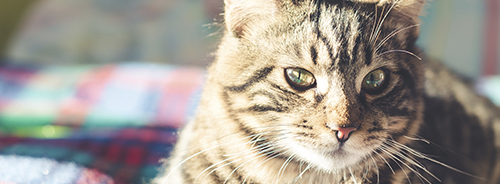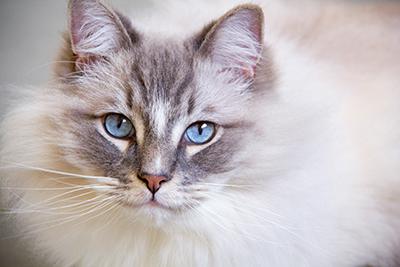
Chronic kidney disease (CKD) is very common in older pets and affects approximately 3 in 10 geriatric cats1. Normally, healthy and happy kidneys do a miraculous job of:
- Eliminating protein wastes
- Balancing body water, salts and acids
- Producing high quality urine
When kidney disease occurs, it compromises the kidney’s abilities to perform these important tasks. Kidney disease can be broken down into two categories:
Chronic kidney disease—When the level of kidney function declines slowly (chronically), cats may compensate for months to years. Mild signs of illness and dehydration will progress as the kidney disease worsens.
Acute kidney disease—If your kitty suffers a severe and/or abrupt injury to the kidneys, as with acute kidney injury (AKI), she may become profoundly ill, and stop producing urine altogether, which too often leads to death.
An important goal of veterinarians is to recognize kidney disease early, when there is a better chance to find and treat an underlying cause or to slow progression, protecting those precious kidneys, and helping your cat to feel well for as long as possible.
Signs of chronic kidney disease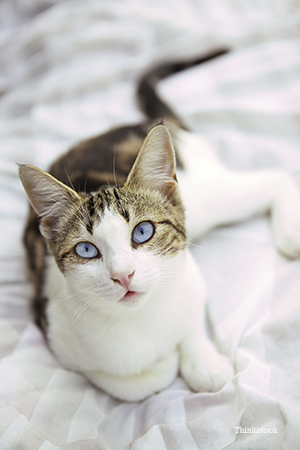 The earliest signs of kidney disease often include increased thirst and urination, but this may be overlooked in cats that drink secretly or share a water dish. Larger clumps of litter, when clumping litter is used (flooding the litter box), is an important clue to illness, and warrants a checkup with your veterinarian.
The earliest signs of kidney disease often include increased thirst and urination, but this may be overlooked in cats that drink secretly or share a water dish. Larger clumps of litter, when clumping litter is used (flooding the litter box), is an important clue to illness, and warrants a checkup with your veterinarian.
Cats with early or mild CKD are often free of signs, but might show:
- Subtle weight loss
- Some increase in urine production and water consumption
Cats with moderate to severe kidney disease might show:
- Decreased appetite
- Vomiting
- Weight loss
- Increased urination and thirst
You will likely notice your cat sleeping more, grooming less and appearing unkempt. Your kitty’s gums may not be as pink as usual indicating anemia. In more severe cases, you might notice an unusual bad breath associated with oral ulcers.
Is my cat at risk of chronic kidney disease?
Certain, unchangeable, factors increase your cat’s risk of chronic kidney disease, such as old age, especially greater than 9 years of age2, or certain breed types. However, other risk factors, that directly initiate kidney damage, can be tested for by your veterinarian and treated, including:
- Pyelonephritis (kidney infection)
- Nephrolithiasis (kidney stones)
- Ureteral obstruction and hydronephrosis (stones causing a blockage)
- Tubulointerstitial disease (disease of the kidney tubules and surrounding tissue)
- Glomerulonephritis (disease of the kidney’s filtering unit, glomerulus)
- Feline infectious peritonitis (FIP)
- Cancer
- Amyloidosis (typically a genetic problem seen in Abyssinian, Siamese, Oriental breeds)
- Polycystic kidney disease (genetic disease seen particularly in Persian cats)
Testing for chronic kidney disease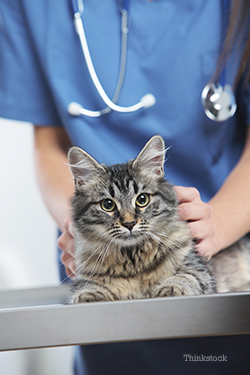 The first test your veterinarian is likely to perform will be a physical examination, and don’t forget that taking your cat in for routine, physical examinations is an excellent way to help protect her. Remember that even normal physical exams may be useful later as a baseline of comparison.
The first test your veterinarian is likely to perform will be a physical examination, and don’t forget that taking your cat in for routine, physical examinations is an excellent way to help protect her. Remember that even normal physical exams may be useful later as a baseline of comparison.
With careful abdominal palpation your veterinarian can detect irregular size and shape of the kidneys (either too large or too small); renal asymmetry (one big and one little kidney); painful kidneys; or possibly firm stones in the urinary pathway, which all confirm urinary disease.
Other physical exam observations that could warn your veterinarian of kidney disease include:
- Low body temperature
- Poor body condition, showing weight loss
- Excessive skin tenting and dry gums showing dehydration
- Unkempt hair coat
- Sharp or bad breath, possibly with ulcers in the mouth
- Pale gums
- Evidence of ocular hemorrhage or blindness associated with high blood pressure (hypertension)
Other tests your veterinarian may run to test for kidney disease include:
- Complete blood count (CBC)—The CBC may reveal anemia (too few red blood cells) or an elevation in white blood cells consistent with infection, stress or inflammation.
- Chemistry profile with electrolytes
- Urinalysis with sediment exam—Examining a urine specimen, especially, prior to any treatment, is a simple and economical way to gauge urine quality.
- Urine culture with susceptibility
- Urine protein to creatinine ratio test
- Diagnostic imaging—Using radiography (X-rays) and ultrasound to identify changes in the size, shape, and architecture of the kidneys and their plumbing may show a need for emergency treatment.
- Infectious disease testing—Routine testing of all sick cats for feline leukemia virus (FeLV) and feline immunodeficiency virus (FIV) is advised. Your veterinarian might recommend other tests looking for infectious diseases.
- Blood pressure measurement—High blood pressure is common in cats with chronic kidney disease.
- Thyroid testing—Hyperthyroidism can mimic or mask signs of kidney disease and frequently affects older cats.
- Kidney Sampling
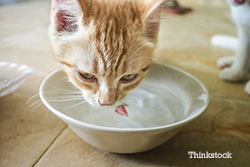
Management of chronic kidney disease
Your veterinarian will customize specific treatments for your kitty depending on how your cat feels, the severity of kidney disease and if your cat has other medical conditions in addition to kidney disease. Some cats may benefit from hospitalization early on, but most cats with early kidney disease will not need external fluid support or intensive care. If your cat is eating and drinking normally, without evidence of dehydration, she will likely get to stay at home, with any medications being prescribed on an out-patient basis.
It is important that your cat with kidney disease takes in enough fluid and eats well. Encouraging your cat to drink can be done by using water fountains, dripping taps and having numerous water sources available. Click here for more ways to encourage your cat to drink more. Adding water to canned food might be acceptable to some cats, but not others. It is important to find what works for your cat. Finding a kidney-friendly diet that she finds palatable could require some trial and error. It’s worth the effort, however, since high quality medical evidence shows that diet is important to slow chronic kidney disease3. Be sure to talk with veterinarian before making any dietary changes. You should stay in touch with your veterinarian and schedule frequent visits as your cat’s disease progresses.
Chronic kidney disease prognosis/advances
Cats can live many years after the diagnosis of early kidney disease, barring decompensation from injury to the kidneys. The discovery of new biomarkers for kidney function such as SDMA, provides for early recognition of kidney disease before other blood values change, and offers the prospect of earlier intervention and kidney care4.
If you have any questions or concerns, you should always visit or call your veterinarian -- they are your best resource to ensure the health and well-being of your pets.
Resources:
- Lulich JP et al. Feline renal failure: questions, answers, questions. Compend Contin Educ Pract Vet. 1992;14(2):127–153
- White JD et al. Naturally-occurring chronic renal disease in Australian cats: a prospective study of 184 cases. Aust Vet J 2006 Jun; 84:188–94
- Polzin DJ et al. Evidence-based management of chronic kidney disease. In Bonagura J, Twedt D (eds), Kirk’s Current Veterinary Therapy XIV, Elsevier Saunders, St Louis 2009: 872-879.
- https://www.idexx.com/small-animal-health/solutions/articles/sdma-diagnose-kidney-disease.html

